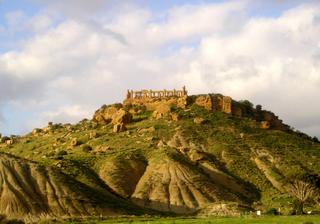Valle dei Templi
 I feel compelled to write about the Valley of the Temples but at a loss of how to do it. Here it is, the site of some of the best preserved Greek temples in the world, one of the Top Ten sites of Sicily, and, really, one of my favorite places in the whole world, and yet I've never written about it? I've tried several times, intended to do so for a year, and yet I still don't have a clue as to how to write anything good enough to describe this place, these temples.
I feel compelled to write about the Valley of the Temples but at a loss of how to do it. Here it is, the site of some of the best preserved Greek temples in the world, one of the Top Ten sites of Sicily, and, really, one of my favorite places in the whole world, and yet I've never written about it? I've tried several times, intended to do so for a year, and yet I still don't have a clue as to how to write anything good enough to describe this place, these temples.I've been to visit the temples at least half a dozen times, and each time my breath is taken away, my heart beats a lit
 tle harder when I come around that last corner in the car and the first temple, dedicated to the goddess Hera, appears, high on its stony cliff, bravely facing the sea. Then Concord comes into view, then the ruin of Hercules. I drive in awe through the valley below them, barely able to keep my eyes on the road, turn up the hill and enter an ancient place and time both enigmatic and beautiful.
tle harder when I come around that last corner in the car and the first temple, dedicated to the goddess Hera, appears, high on its stony cliff, bravely facing the sea. Then Concord comes into view, then the ruin of Hercules. I drive in awe through the valley below them, barely able to keep my eyes on the road, turn up the hill and enter an ancient place and time both enigmatic and beautiful.It doesn't do them justice to give you dates, details of construction or use, or even names, because none of those things matter when I walk up the cobblestone road to the temples. Any season of the year, and I've been there in all of them, it's best to just experience the beauty of the Greek temples and feel their massiveness, their power. How did they survive all the earthquakes of Sicily? Huge, ancient stone blocks are still supported by golden columns. How do they stay up?
I try to go back 2400 years and imagine people in and around these temples, the sacrificial altars . . . priests, virgins, cattle. One huge altar was used to sacrifice a hundred cattle at one time. Another temple has an unusual round altar. What did these people believe the sacrifices accomplished? At the end of the road, I usually sit on one of these altars, look back on four temples and ponder it all. Except for the fences to keep tourists out of the actual interiors, it can't be changed much. The same olive and almond trees and cacti struggle to grow in the rocky terrain.
It never fails to move me in indescribable ways . . . the mystery, the peacefulness, the beauty . . . ancient souls walk with me in the gentle breeze . . . I've been there; we all have.
Are these temples a monument to the gods or to man's artfulness?
Back down the path and across the road to the remains of wh
 at was once one of the largest temples known to man, now just acres of rubble. But upon closer inspection, the rubble is a column here, a pedestal there, an altar, a foundation, a capitol, a chunk of a statue. One of the dozens of Hercules statues that once served as pillars lies on its back on the ground, a favorite photo op for tourists. I think of Shelley's poem, "Ozymandias" every time:
at was once one of the largest temples known to man, now just acres of rubble. But upon closer inspection, the rubble is a column here, a pedestal there, an altar, a foundation, a capitol, a chunk of a statue. One of the dozens of Hercules statues that once served as pillars lies on its back on the ground, a favorite photo op for tourists. I think of Shelley's poem, "Ozymandias" every time:"I met a traveller from an antique land,
Who said: Two vast and trunkless legs of stone
Stand in the desert. Near them, on the sand,
Half sunk, a shattered visage lies, whose frown
And wrinkled lip and sneer of cold command,
Tell that its sculptor well those passions read,
Which yet survive stamped on these lifeless things . . . "
I walk a little further and peer down to the remains of a entire Greek city--nothing now but foundations and random pieces of structures. On the far corner, though, is the last standing corner, just four columns, of the Temple of Castor and Pollux, a symbol of the Valley of the Temples and of Greek Sicily, Magna Graecia.
More Shelley comes to mind:
"Nothing beside remains. Round the decay
Of that colossal wreck, boundless and bare
The lone and level sands stretch far away."
(See Agrigento in My Photos of Sicily at right for many views of the temples.)





